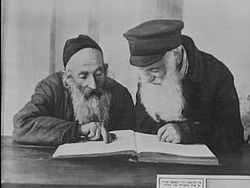Operated by The SS | ||
 | ||
Operational 1 May 1942 – 29 Oct 1942 | ||
The Pińsk Ghetto (Polish: Getto w Pińsku) was a World War II extermination ghetto created by Nazi Germany for the confinement of Polish Jews living in the city of Pińsk (now Pinsk, Belarus) in the eastern territory of occupied Poland. Pińsk was overrun by the Red Army in 1939 during the Soviet invasion of Poland and captured in 1941 by the Wehrmacht in Operation Barbarossa, when it became part of the German Reichskommissariat Ostland.
Contents
During the Red Army's rapid retreat, on 5–7 August 1941 the Waffen SS massacred as many as 11,000 Jewish men of Pińsk aged 16 to 60, due to reports of Soviet guerrilla activity in the area. Their bodies were dumped in hastily constructed mass graves. The subsequent creation of the ghetto was followed – over a year later – by the total eradication of the imprisoned Jewish population of Pińsk, totalling 26,000 victims: men, women and children. Most killings took place between 29 October and 1 November 1942, with the aid of Belarusian Auxiliary Police led by the SS-Ordnungspolizei. No houses were damaged in the process. It was the second largest mass shooting operation in a single settlement to that particular date during the Holocaust, after Babi Yar where the death toll exceeded 33,000 Jews. The Babi Yar shootings were surpassed only by the Nazi Aktion Erntefest of 3 November 1943 in the Lublin district with 42,000–43,000 Jews murdered at once over execution pits, dug specifically for this purpose.
Background
After a century of foreign domination, Poland regained independence at the end of World War I. The Russian Partition has left a legacy of massive 71% percent illiteracy across the region. In April 1919 during the fight against yet another invasion by the Bolsheviks, the new Polish garrison in Pińsk summarily executed 35 Jewish men without due process on the assertion of plotting a pro-Russian counterattack. It was a war crime never forgotten by the Jews of Pińsk. In the subsequent decade the city grew to 23,497 inhabitants as part of the Polesie Voivodeship in the Second Polish Republic. It was briefly declared the capital of the province in 1921 but a city-wide fire resulted in the transfer of power to Brześć within months. Some 108,751 children were sent to elementary schools across the province. Jews constituted over half the number of Pińsk residents, and 17.7% of the general population in the region. New Jewish schools opened, a clinic, the first bank, an old-age home, and an orphanage.
In 1939, following the Soviet invasion in accordance with the Nazi–Soviet Pact against Poland, attitudes of many Jews had changed after encountering the Soviet terror. Pińsk and the surrounding territories were taken over by the Soviet NKVD secret police conducting raids, shut-downs of all synagogues, and shops, as well as mass deportations to Siberia. At that time, the population became over 90% Jewish due to the influx of refugees from the German-controlled western Poland. The area was annexed into the Soviet Byelorussian Republic (doubling its own size) after the NKVD staged elections decided in the atmosphere of terror immediately after the Soviet invasion. All citizens previously living, but also born in Poland, would live in the Byelorussian SSR from then on as the subjects of the Russian judiciary.
Soviet rule was short-lived because the corresponding terms of the Molotov–Ribbentrop Pact signed earlier in Moscow were broken when the German army crossed the Soviet occupation zone on 22 June 1941. From 1941 to 1943 Pińsk was occupied by Nazi Germany, govern by the collaborationist Belarusian Central Council supported by the Nazi Belarusian battalions of the Home Defence. The population of 30,000 included 27,000 Jews. Most of the latter group were murdered in late October 1942 with the help of Belarusian Auxiliary Police when the Pińsk Ghetto was liquidated.
Ghetto resistance and liquidation
The Ghetto in Pińsk existed only for half a year, officially between 20 April and 29 October 1942, much shorter than most Jewish ghettos in German-occupied Poland. The relocation action took place on 1 May 1942. A Judenrat was formed and ordered to provide slave labour for road construction. Food was rationed, and a barbed-wire fence erected. The following month, in June 1942, the first murderous operation took place there, with 3,500 Jews rounded up in Pińsk and nearby Kobryń, and transported to Bronna Góra (the Bronna Mount) to be shot. This was the location of secluded massacres of trainloads of Jews delivered from the Ghetto in Brześć as well.
The Pińsk Ghetto's population swelled, with Jews deported en masse from all neighbouring settlements until food ran out. The subsequent liquidation of the ghetto began on 28 October 1942. The German motorized battalion met armed resistance from underground fighters, which came as a complete shock to the Ordnungspolizei. The insurgents were shooting from secretly set-up bunkers, so reinforcements were brought in, including Belarusian Auxiliary Police, and savage massacres followed. According to the Nazi-issued final report, 17,000 Jews were killed during the insurgency, bringing the total to 26,200 victims before the ghetto's closure. Ten thousand were murdered in one day and the rest on the next day, with few managing to escape into the forest. The ghetto ceased to exist entirely. Not a single house was burned down.
After the war, at the insistence of Joseph Stalin, Poland's borders were redrawn and Pińsk became part of the Soviet Union. Some of the Jews who survived the Holocaust returned, but they were prohibited from reopening a synagogue. In the 1970s and 1980s, most of them emigrated. Pińsk became part of independent Belarus in 1991 after the collapse of the Soviet Union. By 1999, only 317 Jews remained in the city.
